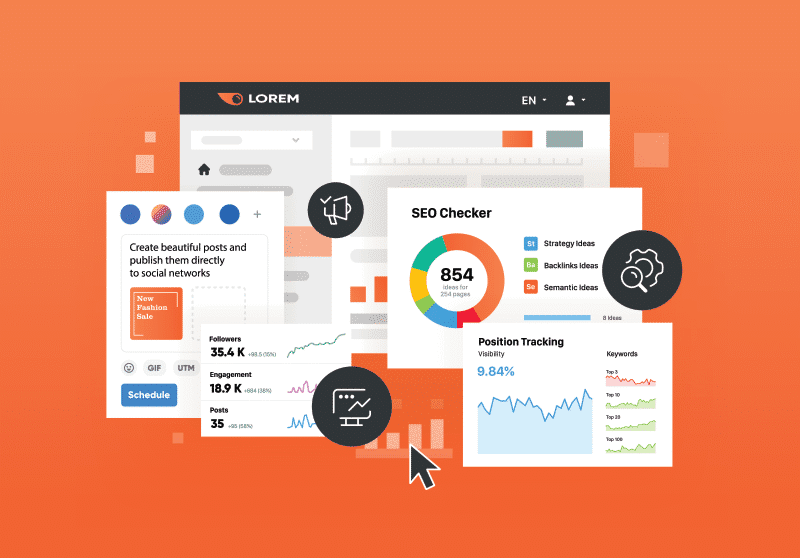Discover
The importance of an SEO audit and its impact on your website’s success
In today’s increasingly competitive digital world, it is important to understand the value of an SEO audit. An SEO audit isn’t just one of many marketing tools; it’s an in-depth process that helps you understand your website’s current position in search engines and identify opportunities to improve it.
As a Velsio digital marketing agency, we are committed to optimising our clients’ websites to ensure they are more visible and better positioned in search results. In this article, we will discuss the importance of an SEO audit and its impact on the success of your website.
SEO audit service general introduction
An SEO audit is a thorough process that assesses a website’s compliance with search engine best practices, with the aim of identifying and correcting elements that affect the site’s organic ranking in search results. This includes in-depth analysis of the website’s technical design, content quality, user experience (UX), inbound link profile and much more. An SEO audit aims to identify issues that may prevent a website from ranking optimally in search engines, while providing strategic recommendations to address these issues.
Why is an SEO audit important?
An SEO audit is important for several reasons:
-
Changing search engine algorithms: search engines like Google are constantly updating and adapting their algorithms to provide users with the most relevant and highest quality search results. An SEO audit will help ensure that your website follows the latest best practices and is therefore better positioned for higher positions in search results.
-
Technical problems: many websites contain technical errors that can negatively affect their ranking in search engines. These can include broken links, slow loading times, lack of mobile-friendliness and more. An SEO audit can help identify and fix these technical problems.
-
Content optimisation: high quality and relevant content is crucial for SEO. An SEO audit evaluates the content of your website to ensure that it is relevant and optimised for target keywords that are relevant to your audience.
-
User experience (UX): a good user experience keeps visitors on your website longer and encourages them to interact with your content, which in turn positively affects your search engine ranking. An SEO audit can help to identify UX issues, such as difficult navigation or slow page load speeds, which can put visitors off.
-
Gaining a competitive edge: an SEO audit provides insights not only into the state of your website, but also into the strengths and weaknesses of your competitors. This information will allow you to adapt your strategy to differentiate yourself from competitors and improve your position in search results.
How can an SEO audit help improve a website’s ranking in search engines?
An SEO audit can help to improve a website’s ranking in search engines by highlighting and resolving a wide range of issues that may be affecting your site’s ranking. The audit proposes an action plan that includes:
- Correction of technical errors such as 404 error pages or slow loading speeds.
- Content optimisation, including keyword strategy and improving content quality.
- Improving the user experience, focusing on fast page loading and intuitive navigation.
- Analysing and improving the profile of backlinks to ensure high quality and relevant links.
- Evaluating social media signals and other factors that may affect the authority and credibility of the site.
All in all, an SEO audit is a fundamental step to ensure that your website is optimised for maximum visibility in search engines. It not only helps to identify and solve existing problems, but also provides strategic guidance on how to achieve better results in the future.

Different types of SEO audit:
There are a number of important types of SEO audit in the process, which help to identify and resolve various issues affecting a website’s ranking in search engines. Below is a further overview of the most common types of SEO audit, in addition to the technical audit, content audit and backlink audit mentioned above.
Technical audit
The technical audit focuses on the technical infrastructure of the website to ensure that search engines can index and rank the page correctly. This includes:
- URL structure analysis
- control of the robots.txt file and meta robots tags
- XML sitemap review
- Page speed testing
- Mobile-friendliness check
Content audit
A content audit looks at the quality, relevance and optimisation of a website’s content to ensure that it meets the search queries of the target audience and the requirements of search engines. This includes:
- Identification of duplicate content
- Keyword optimisation analysis
- Assessing the quality and relevance of content
Backlinks audit
A backlink audit focuses on the analysis of external links pointing to a website, assessing their quality and impact on the authority of the page. This process includes:
- Assessing the quality of links
- Identification of malicious links
- Analysis of link diversity
User Experience (UX) audit
A user experience audit examines the usability and design of a website to ensure a positive user experience, which is an important factor in search engine rankings. This includes:
- User interface and navigation analysis
- Estimation of page load speed
- User-friendliness testing on different devices
Competitor audit
A competitor audit will help you understand the competitive landscape of your niche by analysing the SEO strategies of your main competitors. This gives an overview:
- Competitors’ use of keywords
- Content Strategies
- Backlink profiles
Audit of keywords and content
This type of audit focuses on identifying keyword and content gaps between you and your competitors, helping to identify opportunities to create new and relevant content. This includes:
- Identification of potential keywords not yet covered by your website.
- Benchmarking of content against competitors to identify missing topics or areas.
Security audit
A security audit focuses on the security of a website, identifying potential security risks that could affect user trust and page ranking. It includes:
- Verification of SSL/TLS certificates
- Vulnerability scanning
- Evaluation of security policies
Each type of SEO audit highlights different aspects and issues that need to be addressed to achieve better ranking and visibility of the website in search engines. By combining these audits, you can build a comprehensive picture of the current state of your website and develop a strategy to improve it.
Technical SEO audit components
A technical SEO audit is one of the most important steps in optimising a website, focusing on the technical aspects of the page that affect its indexing, ranking and ranking in search engines. The main components of a technical audit include:
URL structure
- Clarity and logicality: URLs should be short, logical and user-friendly so that both users and search engines can easily understand the content.
- Use of keywords: the use of keywords in the URL helps to improve the relevance of the page for certain queries.
- Canonicalisation: avoid duplicate content problems by indicating the preferred URL as the canonical version.
Robots.txt fail
- Guidance for search engines: this text file instructs search engine robots which pages can be indexed and which cannot, helping to avoid indexing unnecessary pages.
- Correct configuration: make sure that robots.txt does not block important pages or resources that should be available to search engines.
XML sitemap
- List of pages: an XML sitemap is a file containing all the relevant pages of a website, making it easier for search engines to find and index all the content on the site.
- Timeliness: the Sitemap must be kept up to date by adding new pages and removing obsolete or irrelevant pages.
Page speed
- Load time: fast page load time is important for user experience and search engine ranking. Google uses page speed as a factor in page ranking.
- Optimisation methods: Compressing images, minimising page code and optimising server response times are just a few examples of ways to improve page speed.
Mobile-friendliness
- Responsive design: the page must be usable and readable on all devices, including mobile phones and tablets. Google uses mobile-friendliness as an important factor when ranking search results.
- Google mobile-friendliness test: a tool to assess how well your website works on mobile devices.
Other technical aspects
In addition to the above, the following components are also covered by a technical SEO audit:
- HTTPS: Ensure that the website uses a secure connection, which is important for both user security and search engine trust.
- 404 pages: identify and fix broken links leading to 404 error pages, improving both the user experience and the integrity of the site.
- Redirects: optimise the use of 301 redirects to ensure that users and search engines are correctly redirected from old pages to new locations.
Conducting a technical SEO audit ensures that your website is optimally configured for search engines, helping to improve its visibility and ranking in search results.
Importance of a substantive audit
A content audit is a critical process that focuses on a thorough review and analysis of a website’s content. It aims to ensure that content is not only optimised for search engines, but also useful and relevant for the target audience. Resolving the issues identified in the content audit will help improve the website’s ranking in search results, increase traffic and improve the user experience. Below, we look at how a content audit can help identify and address issues around duplicate content, keyword optimisation, content quality and relevance.
Duplicate
- Identifying the problem: Duplicate content occurs when the same or very similar content appears on multiple pages on your own website or on the wider internet. Search engines may then have difficulty deciding which page is most relevant, which may affect your website ranking.
- Solutions: a content audit can help to identify duplicate content and provide solutions such as canonical URLs that tell search engines which page is the “original” or preferred version. It may also suggest rewriting or consolidating content to avoid duplication problems.
Keyword optimisation
- Identifying the problem: Insufficient or excessive use of keywords (so-called keyword stuffing) can affect the ranking of a page in search results. Keyword optimisation involves choosing the right keywords and integrating them naturally into your content.
- Solutions: A content audit will help assess how keywords are currently used and identify ways to better integrate them, while ensuring the naturalness and readability of the content. This may include keyword research to find relevant and competitive keywords that are not yet used in your content.
Quality of content
- Identifying the problem: Low-quality content that does not provide value or meet the needs of users can negatively affect the credibility and ranking of a website.
- Solutions: A content audit can help identify pages that need to be reworked or updated to improve their quality. This can include creating new, refreshing and relevant content that meets the search intentions of the target audience and increases user engagement.
Relevance of content
- Identifying the problem: Content that is not relevant to the target audience or does not match their search intentions may go unnoticed and not generate the expected traffic.
- Solutions: A content audit can help you assess whether your current content meets the interests and needs of your target audience. This can lead to adapting the content strategy to better reflect the search intentions of the target audience, while providing useful and relevant information.
Ultimately, a content audit not only allows you to identify and resolve existing problems with your website content, but also provides valuable insights into how to optimise your content strategy to improve search engine visibility, increase organic traffic and improve the overall user experience.

The importance of a backlink audit
A backlink audit is an important process that helps to assess the quality of external links (backlinks) pointing to a website and the impact on the website’s position in search engine results pages (SERPs). Backlinks, i.e. links from other websites to your page, are one of the most important factors in search engine optimisation (SEO), as they affect the perception of a website’s authority and credibility by search engines. Here is a detailed overview of the importance of a backlink audit and its process.
Assessing the quality of backlinks
-
Identifying authoritative sources: a backlink audit helps to identify whether the links to your website come from trusted and authoritative sources. High quality and relevant links from authoritative sites can significantly improve your website’s ranking in search engines, as they show that your content is considered valuable and trustworthy.
-
Identification of low quality links: the audit also helps to identify low quality or spam links that could have a negative impact on your website. Such links may come from dubious websites or may be part of unethical SEO practices that can lead to Google penalties.
Analysis of the diversity of language profiles
- Assessing the diversity of the link profile: it is important that the backlinks to your website come from different types of websites and from different sources. A backlink audit will help you to assess the diversity of your link profile, including the different domains that link to your site and the types of links (e.g. text links, image links). A diverse link profile shows search engines that your website is widely recognised and relevant to different sources.
Analysis of anchor texts
- Checking the relevance of anchor texts: anchor texts used as link text play an important role in conveying keyword relevance and link context to search engines. The audit helps to analyse whether anchor texts are relevant and diversified, helping to improve the visibility of your website for specific keywords.
Removing harmful links
- Toxic Link Removal Strategy: a backlink audit provides the opportunity to identify and remove toxic or harmful links that could damage your website’s reputation and ranking. This often involves using Google’s disavow tool to inform Google that you do not wish to be associated with certain links.

SEO audit process
An SEO audit is a thorough process that involves a number of steps, from setting objectives to producing an audit report. This process helps to identify and fix problems with a website that may affect its position in search engine results. Below we describe step-by-step how an SEO audit is carried out.
Setting targets
- Defining business and SEO objectives: before starting an audit, it is important to clearly define what you want to achieve. This could include increasing visibility for specific keywords, increasing organic traffic or improving conversion rates.
- Target group and competitor analysis: Understanding who your target audience is and who your main competitors are will help guide the focus of your SEO audit.
Carrying out a technical SEO audit
- Checking the technical infrastructure of the website: this includes analysing the URL structure, the robots.txt file, the XML sitemap, page speed and mobile-friendliness.
- Identifying technical errors: looking for problems that could prevent a website from being correctly indexed and ranked by search engines.
Content audit
- Content quality and optimisation assessment: analysing whether the content of the website is relevant, user-friendly and well optimised for keywords.
- Identifying and resolving duplicate content: looking for content that is duplicated on your own website or elsewhere on the internet and proposing solutions to fix these problems.
Backlinks audit
- Evaluating the quality of incoming links: links to the website are reviewed to assess their authority and relevance.
- Identification of malicious links: low-quality or spammy links are identified and recommended for removal or removal.
Evaluating the user experience (UX)
- Site navigation and usability analysis: to check how easy it is for users to navigate around the site and find the information they need.
- Testing page speed and mobile-friendliness: making sure the website loads quickly and displays correctly on different devices.
Preparing an SEO audit report
- Documenting the problems found: all problems identified during the audit are described in detail, including their impact on the SEO of the website.
- Developing recommendations: an action plan is proposed with concrete recommendations to address the problems identified.
Implementation and ex-post evaluation of the Action Plan
- Implementing SEO improvements: the necessary changes are made to the website based on the recommendations.
- Monitoring the results: after the changes have been made, the performance of the website is monitored to assess the impact of the SEO improvements.
An SEO audit is an ongoing process, not a one-off activity. In order to improve results and maintain or improve the website’s position in search engines, the audit should be repeated regularly, taking into account updates to search engine algorithms and changes to website content.

Common problems that an SEO audit can identify
Broken links
- Problem: Links that don’t direct the user to the target page but give an error message (e.g. 404 error page). These can occur when pages are removed or their URLs are changed.
- Impact: broken links degrade the user experience and can negatively affect the credibility of a website in the eyes of search engines.
Outdated content
- Problem: Content that is outdated or no longer matches users’ search queries.
- Impact: Outdated content can reduce the relevance and authority of a website, negatively affecting its ranking in search results.
Lack of keyword optimisation
- Problem: Content that doesn’t use keywords effectively or is overly keyword stuffing. This means that the content is not sufficiently optimised for search engines or that an unnaturally high number of keywords are used.
- Impact: Failure to optimise keywords can affect a page’s findability in search results, while keyword stuffing can lead to search engine penalties.
Low content quality
- Problem: Content that does not provide value and does not respond to users’ search queries. For example, articles that are too short or content that does not cover the topic in depth.
- Impact: Low-quality content can reduce a website’s authority and credibility, negatively affecting its position in search engines.
Technical problems
- Problem: Problems such as slow load times, lack of mobile-friendliness, incorrect HTTP status codes or misconfigured robots.txt file.
- Impact: Technical problems can prevent a website from crawling and indexing correctly, as well as degrade the user experience, both of which negatively affect search engine rankings.
Inadequate content link strategy
- Problem: Missing or ineffective use of content links. A content link strategy helps to direct traffic to different pages on your website and distribute page authority.
- Impact: An inadequate content linking strategy can limit traffic and authority sharing between pages, negatively affecting the ranking of pages in search results.
Poor user experience (UX)
- Problem: Problems with the navigability, design or interactivity of the website that may make it difficult for users to navigate and find the information they want.
- Impact: Poor user experience can increase bounce rates and reduce the number of pageviews, which in turn negatively affects a website’s position in search results.

How to check your website's SEO indicators independently and for free
SEO (search engine optimisation) is an important component of digital marketing. Fortunately, there are a number of free tools to help you assess the SEO health and speed of your website. Here are some of the best tools to do this:
-
Google Analytics: detailed analysis of your website traffic and user behaviour. Google Analytics.
-
Google Search Console: A tool to monitor your website’s performance in Google search results. Google Search Console
-
GTmetrix: analysis of website load speed and performance. GTmetrix
-
Google PageSpeed Insights: website speed assessment and recommendations for improvement. Google PageSpeed Insights
-
MozBar: Browser extension for quick SEO analysis, including domain and page authority. MozBar
-
Ubersuggest: Keyword ideas, SEO scores and content ideas. Ubersuggest

